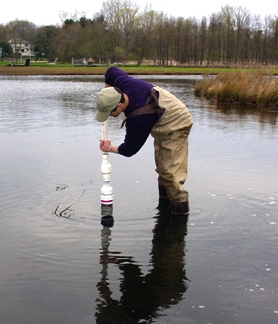Effects of Water Level Change on Nutrient Flux in Wetlands

The International Joint Commission is currently funding the Upper Great Lakes Water Level Study. As part of this initiative, scientists from throughout the region are developing a series of performance indicators to assess the impact of changing water levels on ecosystem health. As part of a team of Great Lakes researchers, the Steinman Lab is investigating the effects of lake level change on coastal wetlands. These wetlands are unique components of the Great Lakes ecosystem. They host a great diversity of plant and animal species, and serve as refugia and breeding grounds for invertebrates, fish, amphibians, reptiles, and birds. Water level fluctuation has the potential to not only influence the rich habitat these wetlands provide, but also the processes that occur within them. Specifically, nutrient release from wetland sediments may be affected by drying and re-wetting due to changing water levels.
We are conducting experiments that involve collecting sediment cores from 8 coastal wetlands (5 eastern Lake Michigan drowned river mouth wetlands and 3 sites in Saginaw Bay).
The sediment cores will be dried in a controlled environment and then re-wetted for 24 hr. We will then measure the resulting nutrient concentrations in the overlying water column of each core. Our performance indicator, nutrient release rates related to water level, will be integrated with other indicators being developed. This information will be used to help inform decision-making regarding the regulation of water levels in the upper Great Lakes.



Funding for this project was provided by the U.S. Army Corps of Engineers through the International Joint Commission
Project Partners:
Central Michigan University
University of Notre Dame
Contacts:
Al Steinman, Project Manager
[email protected]
Mary Ogdahl, Lead Technician
[email protected]

